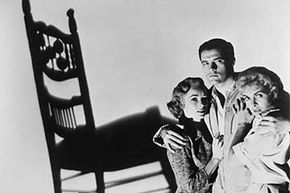What is it about a scary piece of music that makes it instantly frightening? If you're not a music scholar you probably wouldn't be able to pinpoint it in technical terms, but you definitely know scary when you hear it. The shrieking noises, unpleasant-sounding chords, sudden high notes -- they all combine to make us nervous and on edge. But why? Are these inherently scary sounds that provoke an instinctual reaction, or is this a socially conditioned response? Have we been somehow trained to think this type of music is scary?
The answer is both, probably. Music theorists long ago identified the exact combinations of notes that are the most disturbing to our ears, although they never really figured out why they sound so dissonant. The tritone, two notes that are three whole steps apart (like F and B), was known as diabolus in musica (devil in music) in the Middle Ages. Certain combinations of notes, like the tritone, have been carefully avoided throughout history so as not to be associated with any kind of negative emotion.
Advertisement
There's also a scary-by-association factor that might not have anything to do with discordant notes or musical construction. Some musical works are still considered scary today because of their original purpose. The Dies Irae is a Gregorian chant with a mere eight notes and macabre, apocalyptic lyrics. It sounds scary today even to people who can't understand Latin and have no idea it was originally used in Catholic requiem masses. And then there's Bach's "Toccata and Fugue in D-minor," which some argue wasn't considered particularly scary until it was used in movies like "Dr. Jekyll and Mr. Hyde" and "Tales from the Crypt."
But then an evolutionary biologist at the University of California, Los Angeles named Daniel Blumstein came out with two studies (in 2010 and 2012) that suggest that our response to "scary" sound is very much biological -- and that all these composers and movie soundtrack producers have been tapping into instinctual emotional responses when they create spooky music. Blumstein and his team of researchers noticed that the nonlinear chaotic noise made by distressed baby animals -- harsh, screeching, unpredictable sounds meant to get the attention of their parents -- also caused emotional distress in humans. Nonlinear sound is discordant, disturbing and harsh to human ears. Sound familiar?
The researchers then examined more than 100 movie soundtracks (in four genres: horror, drama, adventure and war) and discovered that nonlinear sound is an important part of scenes that are meant to stir up fear and negative feelings. Think "Psycho," "Jaws," "The Shining," "The Exorcist." As far back as 1933's "King Kong," soundtrack engineers had used actual animal cries and screeching to provoke horror in audiences.
So the next time you're on the edge of your seat at a pivotal moment in the latest horror flick, keep your ears trained on the nonlinear noises in the soundtrack. Will it make the moment any less scary if you realize your animal emotional instincts are being manipulated?
Advertisement
